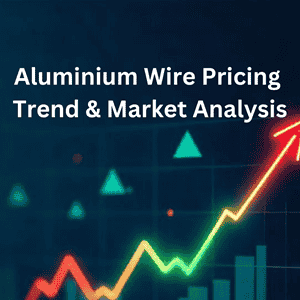
While it doesn’t get much attention, in 2025, the price of aluminium wire has been on the rise — slowly but noticeably.
In today’s world, aluminium wire has become an essential material that quietly powers much of our daily lives. From homes and offices to cars and renewable energy setups, aluminium wire is behind the scenes, doing an important job. While it doesn’t get much attention, in 2025, the price of aluminium wire has been on the rise — slowly but noticeably.
This increase has led many industries to take a closer look. It’s not a sudden jump or a crisis, but it’s steady enough to make people think about where prices are going and what’s driving the change. So, let’s talk about aluminium wire prices in 2025 in the most natural and simple way possible.
One of the clearest reasons for the rise in aluminium wire prices is increased demand. Across the globe, construction projects are in full swing. Whether it’s new residential buildings, commercial spaces, or large infrastructure developments, all of them need electrical wiring. Aluminium wire is a popular choice because it’s lighter and usually cheaper than copper, especially for large-scale installations.
Electric vehicles are another major reason demand has gone up. More people are buying EVs, and more companies are making them. These cars need a lot of wiring to work efficiently, and aluminium wire fits the need because it helps reduce the vehicle’s overall weight.
The same is happening in the clean energy space. Solar panels, wind farms, and energy grids all require wiring to transfer electricity. Aluminium wire is used because it’s reliable, lightweight, and cost-effective. As countries continue investing in greener energy sources, they are also adding to the demand for this vital material.
Aluminium wire doesn’t just come out of the ground ready to use. It starts as bauxite ore, which then has to go through several steps — refining, smelting, shaping — before it becomes the wire used in homes or machines. This entire process requires a lot of electricity.
In 2025, energy prices remain high in many parts of the world. Since electricity is one of the biggest inputs in the aluminium production process, even small increases in energy costs can lead to higher production costs. These higher costs then reflect in the final price of aluminium wire.
There are also other expenses that producers have to deal with — labor, equipment, transportation, and environmental regulations. All of these factors, when added up, make the cost of producing aluminium wire higher than before.
After aluminium wire is produced, it has to be shipped to wherever it’s needed. Often, this involves international transportation, which can include ships, trucks, and trains. Transporting heavy materials like wire is not cheap.
While global logistics have improved compared to previous years, shipping costs in 2025 are still relatively high. Fuel prices, port fees, and shipping delays continue to add extra costs. In countries that rely heavily on imported materials, these logistics challenges have a direct effect on aluminium wire prices.
So, even if the wire is made affordably in one country, getting it to another can still drive up the cost.
One good thing about aluminium is that it can be recycled easily. Recycled aluminium takes much less energy to process, and it can be reused again and again without losing its quality. This makes recycling a valuable way to control production costs and reduce environmental impact.
In 2025, many manufacturers are actively using recycled aluminium to meet demand and lower costs. However, recycling alone isn’t enough. The demand for aluminium wire is growing faster than the supply of recycled aluminium can keep up with. As a result, new aluminium still needs to be produced, which brings us back to higher energy use and production costs.
As we move through 2025, it seems likely that aluminium wire prices will remain steady or continue rising slowly. Demand doesn’t appear to be dropping anytime soon. Energy costs are still uncertain, and global shipping remains a factor.
Some businesses are already adjusting by securing long-term deals with suppliers or by rethinking how they use aluminium wire in their projects. For everyday consumers, the impact might not be obvious right away, but these cost increases can show up in areas like housing, energy bills, or even the price of electric vehicles.
© 2024 Crivva - Business Promotion. All rights reserved.